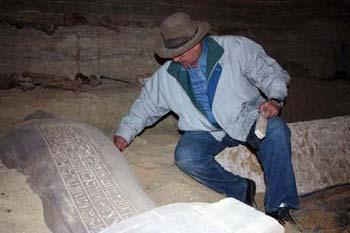Source:
02-11-2009 12:22
Special Report: Tech MaxBEIJING, Feb. 10(Xinhuanet) -- A storeroom housing about two dozen ancient Egyptian mummies has been unearthed inside a 2,600-year-old tomb at the vast necropolis of Saqqara south of Cairo, according to media reports on Tuesday quoting archaeologists.
 |
| A handout picture released by the Egyptian Supreme Council for Antiquities (SCA) shows SCA Secretary General Zahi Hawas clearing dust off a sarcophagus found in Sakkara. Egyptian archaeologists have discovered dozens of mummies and several stone and wood sarcophagi south of Cairo in a pharaonic tomb estimated to be 4,300 years old.(Xinhua/AFP Photo) |
The tomb was located at the bottom of a over 10-meter deep shaft, said Egypt's top archaeologist, Zahi Hawass. Twenty-two mummies were found in niches along the tomb's walls, he said.
Eight sarcophagi were also found in the tomb. Archaeologists so far have opened only one of the sarcophagi — and found a mummy inside of it, said Hawass' assistant Abdel Hakim Karar.
The "storeroom for mummies" dates back to 640 B.C. during the 26th Dynasty, which was Egypt's last independent kingdom before it was overthrown by a succession of foreign conquerors beginning with the Persians, Hawass said.
Most of the mummies are poorly preserved, and archeologists have yet to determine their identities or why so many were put in one room.
The name Badi N Huri was engraved into the opened sarcophagus, but the wooden coffin did not bear a title for the mummy.
Karar also said it was unusual for mummies of this late period to be stored in rocky niches.
Excavations have been ongoing at Saqqara for 150 years, uncovering a necropolis of pyramids and tombs dating mostly from the Old Kingdom but also tombs from as recent as the Roman era.
